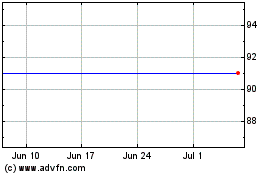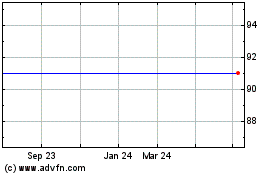OKYO Pharma Announces Promising Categorical Data from OK-101 Phase 2 Trial in Dry Eye Disease
July 10 2024 - 6:00AM
UK Regulatory
OKYO Pharma Announces Promising Categorical Data from OK-101 Phase
2 Trial in Dry Eye Disease
- Encouraging 68% improvement in responder rate results from
patients who achieved both the conjunctival staining “sign” and
ocular pain “symptom” endpoints from the 240 patient Phase 2 Dry
Eye Disease (DED) trial
- Conjunctival staining and ocular pain represent potential
co-primary endpoints to be explored in future trials
LONDON and NEW YORK, July 10, 2024 (GLOBE NEWSWIRE) -- OKYO
Pharma Limited (NASDAQ: OKYO), a clinical-stage biopharmaceutical
company developing innovative ocular therapies for the treatment of
inflammatory dry eye disease (DED), a multi-billion-dollar market,
and neuropathic corneal pain (NCP), an ocular condition associated
with pain but without an FDA approved therapy, today announced
promising new categorical data analyses from the recent OK-101
Phase 2 trial in DED patients. These analyses have identified
conjunctival staining and ocular pain as the highest potential
“sign” and “symptom” co-primary endpoints to be explored in the
next DED trial of OK-101.
“The data from this first in-human trial of OK-101 in patients
with DED have established a clear road map for future clinical
development in this indication,” said Gary S. Jacob, Ph.D., CEO of
OKYO Pharma. “Through our analytical work we have concluded that
conjunctival staining and ocular pain represent important and
de-risked endpoints to be studied further to help underserved
patients whose dry eye symptoms include pain component.
Furthermore, this trial demonstrated a favorable tolerability
profile for OK-101, with an excellent eyedrop comfort score for a
topically administered drug.”
“Dry eye disease encompasses a diverse and dissatisfied patient
population who needs treatment alternatives to available
anti-inflammatory medicines which are insufficient to alleviate the
broad spectrum of bothersome ocular symptoms encompassed by this
condition,” said Gabriele Cerrone, Non-Executive Chairman of OKYO
Pharma. "We continue to advance our innovative program which
focuses on the segment of patients most impacted by ocular pain,
and will evaluate next steps for dry eye with our advisors and the
regulatory agencies.”
Categorical Analysis Details:
Recently released data from the Phase 2, randomized,
double-masked, placebo-controlled trial evaluating the safety and
efficacy of OK-101 ophthalmic solution in subjects with DED were
analyzed by categorical evaluation of the data set and
responder-rate analyses. Importantly, the data set for the analysis
utilized the full Intent-to-Treat population of 240 patients (for
additional details, please refer to slides in the recently issued
6-K filing).
Key findings are highlighted in Figure 1 below which evaluated
responder rates for those patients demonstrating at least 12.5%
reduction in conjunctival sum staining combined with at least a 30%
reduction in the observed symptom (i.e., ocular pain, blurred
vision, burning/stinging) as measured by improvement from baseline
through the last study visit at Day 85.

- Notably, the number of patients showing both a reduction in
conjunctival sum staining and in the pain symptom in the
OK-101-treated group was 34.2% compared to 20.3% in the
placebo-treated group, a 68% improvement.
- Similarly, the number of patients with reduction in
conjunctival sum staining and burning/stinging symptoms were also
numerically higher in the OK-101-treated group (32.9%) compared to
the placebo-treated group (20.3%), with a 62% improvement.
- There was a smaller 19% difference in the responder rates for
patients reporting both a combination of conjunctival staining and
blurred vision.
FDA requires a “sign” and a “symptom” endpoint in two well
controlled registration trials for approval.
https://www.fda.gov/media/144594/download
About Dry Eye Disease
Dry eye disease is a common condition that occurs when an
individual’s tears are unable to adequately lubricate the eyes.
This condition affects approximately 49 million people in the U.S.
alone and has been a difficult one to positively diagnose and to
treat due to the multifactorial nature of the condition. A number
of contributing factors can lead to this condition, including age,
sex, certain medical conditions, reduced tear production and tear
film dysfunction. Tear film instability typically leads to
inflammation and damage to the ocular surface.
About OK-101
OK-101 is a lipid conjugated chemerin peptide agonist of the
ChemR23 G-protein coupled receptor which is typically found on
immune cells of the eye responsible for the inflammatory response.
OK-101 was developed using a membrane-anchored-peptide technology
to produce a novel long-acting drug candidate for treating dry eye
disease. OK-101 has been shown to produce anti-inflammatory and
pain-reducing efficacy signals in mouse models of dry eye disease
and corneal neuropathic pain (NCP), respectively, and is designed
to combat washout through the inclusion of the lipid anchor built
into the drug molecule to enhance the residence time of OK-101
within the ocular environment. OK-101 recently showed statistical
significance in multiple endpoints in a recently completed Phase 2,
multi-center, double-blind, placebo-controlled trial of OK-101 to
treat DED.
About OKYO
OKYO Pharma Limited (NASDAQ: OKYO) is a clinical stage
biopharmaceutical company developing innovative therapies for the
treatment of DED and NCP, with ordinary shares listed for trading
on the NASDAQ Capital Market. OKYO is focused on the discovery and
development of novel molecules to treat inflammatory DED and ocular
pain. In addition to the recently completed Phase 2 DED trial, OKYO
also has plans underway for the opening of a Phase 2 trial for
OK-101 to treat NCP in patients with this debilitating condition.
For further information, please visit www.okyopharma.com.
Forward-Looking Statements
Certain statements made in this announcement are forward-looking
statements. These forward-looking statements are not historical
facts but rather are based on the Company’s current expectations,
estimates, and projections about its industry, its beliefs, and
assumptions. Words such as ‘anticipates,’ ‘expects,’ ‘intends,’
‘plans,’ ‘believes,’ ‘seeks,’ ‘estimates,’ and similar expressions
are intended to identify forward-looking statements. These
statements are not guarantees of future performance and are subject
to known and unknown risks, uncertainties, and other factors, some
of which are beyond the Company’s control, are difficult to
predict, and could cause actual results to differ materially from
those expressed or forecasted in the forward-looking statements.
These and additional risks and uncertainties are described more
fully in the company’s filings with the SEC, including those
factors identified as “Risk Factors” in our most recent Annual
Report on Form 20-F, for the fiscal year ended March 31,
2023. The Company cautions security holders and prospective
security holders not to place undue reliance on these
forward-looking statements, which reflect the view of the Company
only as of the date of this announcement. The forward-looking
statements made in this announcement relate only to events as of
the date on which the statements are made. The Company will not
undertake any obligation to release publicly any revisions or
updates to these forward-looking statements to reflect events,
circumstances, or unanticipated events occurring after the date of
this announcement except as required by law or by any appropriate
regulatory authority.
Enquiries:
|
OKYO Pharma Limited |
Gary S. Jacob, Chief Executive Officer |
917-497-7560 |
| Business Development
& Investor Relations |
Paul Spencer |
+44 (0)20 7495 2379
|
A photo accompanying this announcement is available at
https://www.globenewswire.com/NewsRoom/AttachmentNg/eaefc657-3c15-4cbe-9fa5-956b32a662fc


Okyo Pharma (LSE:OKYO)
Historical Stock Chart
From Oct 2024 to Nov 2024

Okyo Pharma (LSE:OKYO)
Historical Stock Chart
From Nov 2023 to Nov 2024


